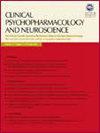儿童注意力缺陷多动障碍精氨酸/一氧化氮途径的改变及哌甲酯治疗10周的疗效
IF 2.4
4区 医学
Q3 NEUROSCIENCES
引用次数: 2
摘要
目的探讨精氨酸、一氧化氮(NO)、不对称二甲基精氨酸(ADMA)和肾上腺髓质素在注意力缺陷多动障碍(ADHD)病因中的作用,并与健康对照组进行比较。方法30名ADHD患者和30名6-12岁的健康对照者参与研究。社会形态数据表,学龄儿童情感障碍和精神分裂症一览表,现有和终身版本;康纳斯家长/教师评分表修订长表;儿童抑郁量表;儿童状态特质焦虑量表应用于所有病例。纳入研究的所有参与者都根据其血清精氨酸、NO、ADMA和肾上腺髓质素水平进行了评估。随后,开始对ADHD患者进行哌甲酯治疗,并在治疗的第十周再次检测血液参数。结果在研究开始时,与对照组相比,ADHD组的精氨酸和ADMA水平显著升高,NO和肾上腺髓质素水平显著降低。治疗后精氨酸和ADMA水平显著低于治疗前。治疗前后no和肾上腺髓质素水平无显著差异。量表评分与血液参数之间没有相关性。结论ADHD患者血液参数的变化值得进一步研究。在长期治疗后对更大样本组进行的研究可能会提供与多动症病因和治疗相关的神经生物学过程变化的新信息。本文章由计算机程序翻译,如有差异,请以英文原文为准。
Altered Arginine/Nitric Oxide Pathway in Children Diagnosed Attention Deficit Hyperactivity Disorder, and the Effect of 10 Weeks Methylphenidate Treatment
Objective In this study, we investigated the levels of arginine, nitric oxide (NO), asymmetric dimethylarginine (ADMA), and adrenomedullin that are presumed to play a role in attention deficit hyperactivity disorder (ADHD) etiology, and to compare the findings with healthy controls. Methods Thirty ADHD patients and thirty healthy control subjects aged 6−12 years were included in the study. Sociodemographic data form, Schedule for Affective Disorders and Schizophrenia for School Age Children-Present and Lifetime Version; Conners’ Parent/Teacher Rating Scale-Revised Long Form; Children’s Depression Inventory; and The State-Trait Anxiety Inventory for Children were applied to all cases. All participants included in the study were evaluated in terms of their serum arginine, NO, ADMA, and adrenomedullin levels. Subsequently, methylphenidate treatment was started in ADHD patients and blood parameters were tested again in the tenth week of treatment. Results At the start of the study, arginine and ADMA levels were significantly higher and NO and adrenomedullin levels were significantly lower in the ADHD group compared to the control group. Post-treatment arginine and ADMA levels were found to be significantly lower than in the pre-treatment period. There were no significant differences in NO and adrenomedullin levels before and after treatment. There was no correlation between scale scores and blood parameters. Conclusion These variations in the blood parameters of the ADHD group seem to be worth further investigation. Studies to be conducted with larger sample groups after longer-term treatment may provide new information about the alterations in neurobiological processes related to ADHD etiology and treatment.
求助全文
通过发布文献求助,成功后即可免费获取论文全文。
去求助
来源期刊

Clinical Psychopharmacology and Neuroscience
NEUROSCIENCESPHARMACOLOGY & PHARMACY-PHARMACOLOGY & PHARMACY
CiteScore
4.70
自引率
12.50%
发文量
81
期刊介绍:
Clinical Psychopharmacology and Neuroscience (Clin Psychopharmacol Neurosci) launched in 2003, is the official journal of The Korean College of Neuropsychopharmacology (KCNP), and the associate journal for Asian College of Neuropsychopharmacology (AsCNP). This journal aims to publish evidence-based, scientifically written articles related to clinical and preclinical studies in the field of psychopharmacology and neuroscience. This journal intends to foster and encourage communications between psychiatrist, neuroscientist and all related experts in Asia as well as worldwide. It is published four times a year at the last day of February, May, August, and November.
 求助内容:
求助内容: 应助结果提醒方式:
应助结果提醒方式:


